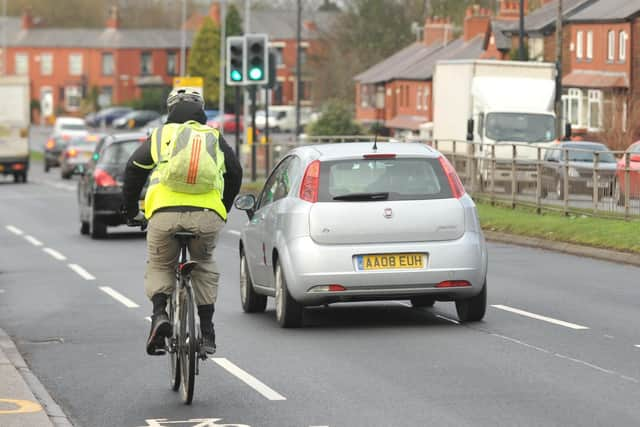Wigan has fourth highest percentage of deaths linked to toxic air in North West
and live on Freeview channel 276
Estimates from the Centre for Cities’ annual study shows that 133 adults in the borough died as a result of toxic PM2.5 emissions in 2017.
The borough’s air-pollution fatalities accounted for around 4.1 per cent of all deaths in Wigan for the time frame examined - placing it joint fourth on the nine-strong list with Burnley, though the latter only had 77 deaths.
Advertisement
Hide AdAdvertisement
Hide AdWarrington placed third with 83 deaths linked to air pollution while Manchester, which had almost as many deaths as the other eight regions combined, came second in the rankings.


The proportion of deaths related to the deadly toxin PM2.5 are highest in Liverpool, with the latest data linking it to 279 deaths in just one year, or 4.6 per cent of all adult deaths in the city.
The results indicate that more than one in 23 deaths in the North West’s largest cities and towns were related to long term exposure to air pollution, according to the figures.
The Centre for Cities said that transport was a significant, but not sole contributor to air pollution; adding that burning fuels was also a major cause. For example, half of deadly PM2.5 toxins generated in cities and large towns come from sources such as wood burning stoves and coal fires. And not all of it is locally generated – some in the south of England is blown in from continental Europe.
Advertisement
Hide AdAdvertisement
Hide AdThe proportion of deaths related to the deadly toxin PM2.5 was highest in cities and large towns in south eastern England such as Slough, Luton and London, where an estimated one in 16 people die from exposure.


Half of local authority leaders polled by Centre for Cities highlighted the environment as a major concern, but progress has been slow and they must do more to prevent more avoidable deaths from air pollution.
The Centre called on cities in the North West to introduce Ultra Low Emission Zones to charge car and van drivers in city centres, and ban the use of wood burning stoves and coal fires in areas where air pollution exceeds guidelines.
Meanwhile, the UK Government should do more to help politicians in the North West act, the Centre said, by adopting the World Health Organisation’s stricter guidelines on PM2.5 – as the
Advertisement
Hide AdAdvertisement
Hide AdScottish Government has already done – and make a legally binding commitment to meet this by 2030 at the latest.
Andrew Carter, Chief Executive of Centre for Cities, said: “More than half of people in the UK live in cities and large towns. And while they offer people good employment and lifestyle opportunities Cities Outlook 2020 shows that they also having a damaging effect on their health, with air pollution killing thousands of people living in cities every year.
“Politicians often talk tough on addressing air pollution but we need to see more action. People in the North West should be at the centre of the fight against its toxic air and councils should take the steps needed, including charging people to drive in city centres and banning wood burning stoves.
“To help the Government needs to provide the North West’s councils with extra money and introduce stricter guidelines. The deadly levels of polluted air in the North West are entirely legal. This needs to change. As a matter of urgency the Government should adopt WHO’s stricter guidelines around PM2.5 emissions. Failure to act now will lead to more deaths in the North West.”
Advertisement
Hide AdAdvertisement
Hide AdProf Kate Ardern, Wigan Council’s director of public health, said: “We understand that poor air quality in Greater Manchester is a major issue affecting people’s health right now.
“As part of our recent Deal 2030 big listening event, many of our residents and young people said they want to see a greener borough with less pollution.
“The major air pollutant of concern across much of the borough is nitrogen dioxide (NO2), the primary source of which is emissions from road transport and despite our overall air quality being within legal limits, we must continue to take steps to tackle air pollution collectively.
“We will look to address poor air quality through a number of measures which include supporting the development of the Greater Manchester Clean Air Plan, more investments into walking and cycling infrastructure that add to Saddle Junction and last year’s opening of the Muddy Mile, along with our anti-idling campaign which encourages parents to turn off their car engines outside school.
Advertisement
Hide AdAdvertisement
Hide Ad“Taxis in the borough have also been given a £20 reduction in licence fees for low emission vehicles, and a 50% reduction for electric vehicles.
“With the help of funding from Greater Manchester, we plan to install dozens of electric chargers around the borough encouraging residents to take up less polluting driving options.”
PM2.5-related deaths in the North West
Total number of PM2.5 related deaths in 2017 across the North West - 1921
1. Liverpool - 279 - 4.6%
2. Manchester - 923 - 4.3%
3. Warrington - 83 - 4.3%
4. Wigan - 133 - 4.1%
5. Burnley - 77 - 4.1%
6. Blackburn - 50 - 4%
7. Preston - 136 - 4%
8. Birkenhead - 136 - 3.9%
9. Blackpool - 104 - 3.5%
What is PM2.5?
Particulate matter (PM) is a mixture of solid particles and liquid droplets in the air. It can be either human-made or naturally occurring. Examples include dust, ash and sea-spray. PM2.5 means the mass per cubic metre of air of particles with a size (diameter) generally less than 2.5 micrometres (µm).
Advertisement
Hide AdAdvertisement
Hide AdInhalation of PM2.5 can negatively affect health and there is no safe threshold below which no adverse effects would be anticipated.
The biggest impact of particulate air pollution on public health is understood to be from long-term exposure to PM2.5, which increases the age-specific mortality risk, particularly from cardiovascular causes.